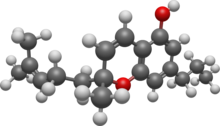
| |

| |
| Names | |
|---|---|
| IUPAC name
2-methyl-2-(4-methylpent-3-enyl)-7-propylchromen-5-ol
| |
| Other names
Cannabivarichromene, CBCV
| |
| Identifiers | |
3D model (JSmol)
|
|
| ChemSpider | |
PubChem CID
|
|
| UNII | |
CompTox Dashboard (EPA)
|
|
| |
| |
| Properties | |
| C19H26O2 | |
| Molar mass | 286.415 g·mol−1 |
Except where otherwise noted, data are given for materials in their standard state (at 25 °C [77 °F], 100 kPa).
| |
Cannabichromevarin (CBCV), also known as cannabivarichromene) is one of over 100 variants of cannabinoid chemical compounds that act on cannabinoid receptors.[1][2] CBCV is a phytocannabinoid found naturally in cannabis, and is a propyl cannabinoid and an effective anticonvulsant and used to treat brain cancer and epilepsy[citation needed]
CBCV was first identified at the University of Nagasaki in 1975 from marijuana from Thailand. CBCV is not thought to be psychoactive or impairing in any way, and is believed to be safe for children and adults and is a compound found in medical marijuana.[3]
References[edit]
- ^ "(±)-Cannabichromevarin (CRM) (CAS 41408-19-9)". www.caymanchem.com. U.S.: Cayman Chemical Company. Retrieved 2019-12-23.
- ^ PubChem. "Cannabichromevarin". pubchem.ncbi.nlm.nih.gov. U.S. National Library of Medicine, National Institutes of Health. Retrieved 2019-12-23.
- ^ "What is Cannabichromevarin - CBCV? | Ionization Labs".
- ^ "United States Patent: 9084771 - Methods and compositions for treating cancer".